Persian rug pads keep the valuable Persian rugs on floor. Persian rug pad will keep the rug from moving around. This also helps the rug not wear out as quickly. When a rug does not move around, it won’t wrinkle up and wear out extending the life of the rug
Normally Rug pads seems not so important for most people, but they keep your rug from any kind of damages. Most people don’t think about buying a rug pad when they buy a rug. They just put their rug in its place not realizing that they need this overlooked accessory.
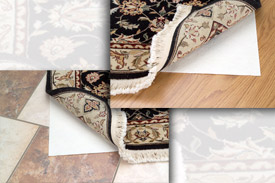
How Do You Buy Persian Rug Pad or For Others Also?
Although hidden from view under your carpet, buying (oriental) Persian rug pad is an important decision.
If a salesperson tries to get you to spend a little more on pad, don’t assume that it’s an unnecessary upgrade. Getting high-quality pad increases the life of your expensive carpet.
It also makes carpet more comfortable to walk on, provides cushioning for small children to play on, reduces noise and helps insulate your home. 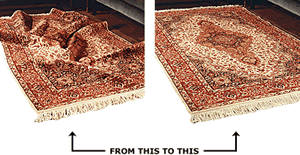 Compare area rug pad materials and benefits. The vast majority of residential pad is made from polyurethane foam. This type of pad is called re-bond because it is made of pieces of recycled foam bonded together and has a multi-color appearance. Other types of pad are made from rug fibers, felt, rubber or urethane
Compare area rug pad materials and benefits. The vast majority of residential pad is made from polyurethane foam. This type of pad is called re-bond because it is made of pieces of recycled foam bonded together and has a multi-color appearance. Other types of pad are made from rug fibers, felt, rubber or urethane
Choose the proper thickness and density. Commercial, loop and low-pile carpet perform better with a thinner, denser pad. For cut pile, found in many homes, use pad no thicker than 1/2 inch but with a density of at least 5 lb. More dense pads are even better for cut pile.
Select an area rug pad with a moisture barrier if you have pets that like to urinate on the carpet. The moisture barrier is also logical for a family with young kids who are more likely to spill on the carpet. Fluids cannot penetrate into the pad causing stains to re-emerge or odors to linger.
 !!!Replace Persian rug pad when replacing your rug. Pad breaks down over time and absorbs odors that are not good for your brand new carpet investment.
!!!Replace Persian rug pad when replacing your rug. Pad breaks down over time and absorbs odors that are not good for your brand new carpet investment.
!!!Using pad that is too thick causes wrinkling in the carpet and then the carpet needs to be re-stretched. It can also put stress on the carpet seams and the seams will start to separate.
YOU can Install Persian Rug Padding..
Here is HOW
Removing Old Underlay
Removing old one is not so hard you can do it by yourself at your home but you should need some kind of materials which areGloves, Pliers, Solvent, Utility knife or carpet knife, Tackless strips, Nails, Stapler, Hammer.
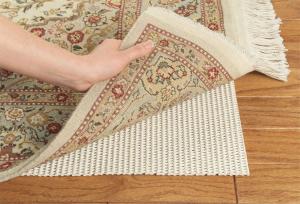
*Collect the following: hammer, nails, gloves, tackless strips, utility knife or carpet knife, stapler and pliers.
*Start at an edge and pull up old carpet underlay and discard it.
*Use pliers to pull up all the staples that held the underlay to the floor. (Any staples left behind will create bumps in the new underlay and carpet.)
*Remove glued underlay. This will require pulling up by hand as much old underlay as you can, and then applying a solvent (such as a citrus stripper) to soften the glue and scraping the remaining underlay off the floor.
How Do You Install Integral-Pad Rug?
Integral pad carpeting is simply carpet with a layer of padding pre-attached to the back. It can make installation quicker and easier. This type of carpet can be laid on any smooth, dry surface including sealed cement.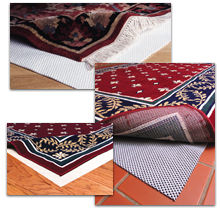
Measure and Cut
Measure the area to be carpeted, taking the length and width of the room.
Cut the carpet so that it measures an extra inch on each side. For example, if the room was 70 inches wide, you would want the carpet to be 72 inches wide.–one extra inch on each side.
Lay the carpet down in the room. If you have more than one piece, make sure the piles are going in the same direction. If you only have one piece of carpet, you won’t have to worry about seams and can skip ahead to Section 3.
!!!If the room was previously carpeted, you will want to remove any tack strips that might still be there.
Joining Seams
Pull back one piece of carpet where the pieces meet. Draw a line on the floor by running a pencil next to the piece of carpet that is still laying on the floor.
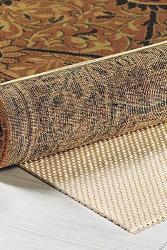
Pull back the second piece of carpet. Do not put the first piece of carpet back down yet. Apply carpet tape to the floor, carefully centering it above the line you drew.
Pull paper backing off the tape. Lay one piece of carpet down so it covers half the tape.
Apply a line of seam adhesive to the edge of the carpet that is now attached to the tape. Lay the second piece of carpet on top of the remaining tape.
Press the carpet firmly into place with a seam roller. If you don’t have a seam roller, raid your kitchen for a rolling pin. Brush the carpet pile together to help the seam disappear from view.
Finishing the Outer Edges
Pull back two adjoining outer edges. Be careful not to slide the carpet out of place.
Apply a border of carpet tape on the now exposed floor. Smooth the tape and then remove the paper backing. 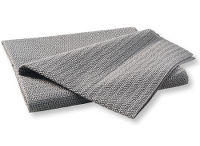 Drop the rug onto the tape. Use your hands to smooth the carpet above the tape, so it can get a good grip. Repeat with remaining sides of the room. Trim excess carpet from the edges.
Drop the rug onto the tape. Use your hands to smooth the carpet above the tape, so it can get a good grip. Repeat with remaining sides of the room. Trim excess carpet from the edges.
Push edges under the baseboard to finish. Or put a shoe molding in place on top of the carpet. Secure the shoe molding by nailing it into the baseboard, not the floor
!!!These instructions covered the installation of up to two pieces of integral-pad carpet with only one seam. It is possible to do more, but you will have to repeat the seam process as necessary.
!!!It is possible to use an adhesive to adhere integral-pad carpet to the floor underneath. However, if the carpet is to be removed at a later time, the adhesive could leave a hard-to-remove residue.
Take one Persian rug pad if you really want take care your Persian rugs
Return from Persian Rug Pad to Persian Rugs